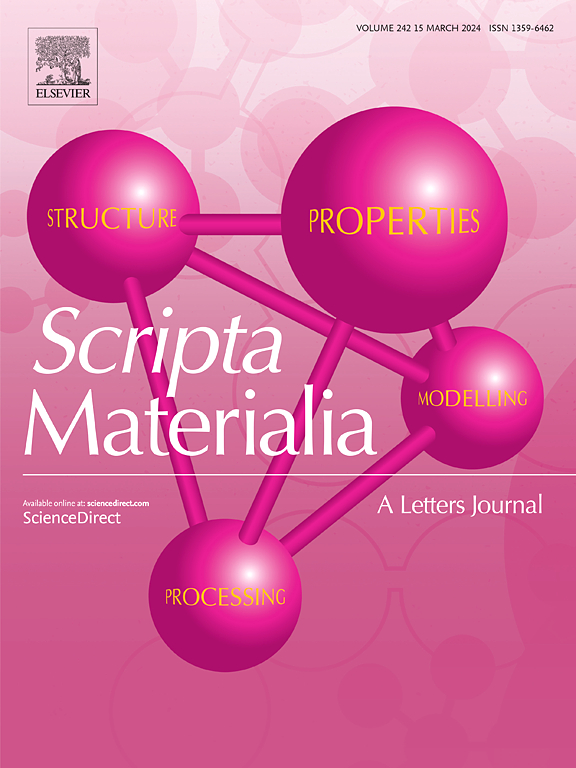TiZrHfNbx多主元素合金成分相关的相工程
IF 5.3
2区 材料科学
Q2 MATERIALS SCIENCE, MULTIDISCIPLINARY
引用次数: 0
摘要
Ti-/Zr-/Hf-合金的相工程对下一代结构材料至关重要,但缺乏对成分驱动的相演化及其动力学的理解阻碍了它们的设计。本文研究了TiZrHfNbx (x = 0-0.4)合金的相变途径和动力学,揭示了Nb含量对合金相稳定性和相变机理的影响。多尺度分析表明,Nb的加入促进了HCP (α)→BCC (β)的转变,降低了α→β的温度,同时提高了活化能。确定了两种不同的转变途径,β→α (Burgers机制)和β→ω(坍缩机制)。中间ω相的析出有两种模式:无扩散淬火的ω- ath和溶质重分布的等温时效ω- iso。建立了成分、相构成和动力学之间的定量关联,为多组分合金的非平衡相变提供了见解。所报道的涉及BCC↔HCP / BCC↔ω的相变机制为基于tizrhfnb的系统中的相位工程提供了一个框架。本文章由计算机程序翻译,如有差异,请以英文原文为准。

The compositional-dependent phase engineering in TiZrHfNbx multi-principal element alloy
Phase engineering of Ti-/Zr-/Hf- alloys is critical for next-generation structural materials, yet the lack of understanding of composition-driven phase evolution and its kinetics impedes their design. This study investigates the phase transition pathways and kinetics in TiZrHfNbx (x = 0–0.4) alloys, revealing the influence of Nb content on phase stability and transition mechanisms. Multi-scale analyses have proven that Nb addition drives HCP (α)→BCC (β) transition, lowering α→β temperature while increasing activation energy. Two distinct transition pathways, β→α (Burgers mechanism) and β→ω (collapse mechanism), are identified. Intermediate ω-phase precipitation occurs via two modes: quenched athermal (ωath) through a diffusionless process, and aged isothermal (ωiso) companied with solute redistribution. A quantitative correlation between composition, phase constitution, and kinetics is established, providing insights into nonequilibrium phase transitions in multicomponent alloys. The reported phase transition mechanisms involving BCC↔HCP / BCC↔ω offering a framework for phase engineering in TiZrHfNb-based systems.
求助全文
通过发布文献求助,成功后即可免费获取论文全文。
去求助
来源期刊

Scripta Materialia
工程技术-材料科学:综合
CiteScore
11.40
自引率
5.00%
发文量
581
审稿时长
34 days
期刊介绍:
Scripta Materialia is a LETTERS journal of Acta Materialia, providing a forum for the rapid publication of short communications on the relationship between the structure and the properties of inorganic materials. The emphasis is on originality rather than incremental research. Short reports on the development of materials with novel or substantially improved properties are also welcomed. Emphasis is on either the functional or mechanical behavior of metals, ceramics and semiconductors at all length scales.
 求助内容:
求助内容: 应助结果提醒方式:
应助结果提醒方式:


